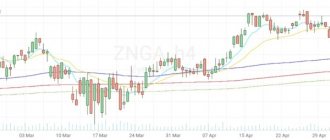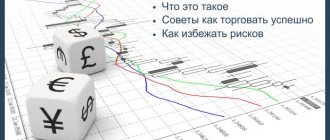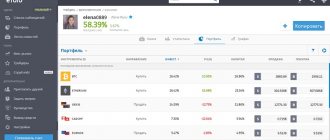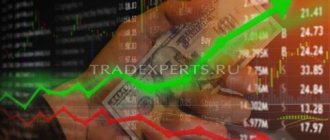Forex is a financial market where currency pairs are bought and sold in order to make a profit. In Forex, trading is always carried out in currency pairs and in fact it turns out that you are always selling one currency pair to buy another.
To trade the Forex market, a trader will need to open an account with a broker. After this, you will be given the opportunity to trade on a margin basis. If we are talking about margin trading on the foreign exchange market, then in this case the broker will provide you with leverage, i.e. borrowed funds.
In this article, we will look at what margin trading is, see how to calculate margin and, taken together, this knowledge will give you an understanding of the associated risks.
What is margin trading in the Forex market
In the classical sense, margin trading is trading using borrowed funds. These funds are provided by the broker on collateral called margin
.
The concept of “margin trading” = “trading with leverage”
. Those. It is the same.
That is, the broker provides the trader with his own funds for trading under a small collateral from the trader’s deposit. It is on this principle that leverage is built, which allows you to conclude transactions for amounts many times greater than the size of the trader’s account.
The idea is simple. The greater the amount of funds you trade, the greater the profit you can make.
Margin trading is essentially the same as short-term lending of funds, which is very risky, but in the long term it can lead to higher profits.
How does margin trading work?
Margin trading should be viewed as a way of borrowing funds by pledging a portion of your own capital, rather than as an additional cost or commission expense.
To begin margin trading, a trader opens an account with a broker, after which he uses the required percentage of the total amount of funds required to cover the entire transaction amount. The interest is calculated to cover any losses that may arise.
Margin is the portion of a trader's funds that are reserved for the entire time your trade is open.
When the trade is completed, the margin is returned to the trader's account, i.e. in fact, part of the funds is returned to the trader’s account. And then these funds can be used to open new transactions.
What are the advantages of margin trading on Forex?
The main advantage for a Forex trader using margin is the ability to multiply the potential profit on an investment many times over. They can use margin trading to trade much larger amounts than they initially have in their account.
Unlike regular stock brokers, forex brokers generally do not charge commissions on the funds they provide as collateral to cover traders' positions.
The margin of a Forex broker is much higher than the margin provided by a stock broker. If, for example, a forex broker has a ratio of equity to borrowed funds of 1:10, then for a stock broker this figure is 1:2. This means that forex traders have significantly higher earning potential, but at the same time, a more significant risk.
Now let's look at an example. Let's say we have a forex trader who came to the market with $100. And it will use a ratio (leverage) of 1:50. Thus, he will be able to operate with an amount of $5,000. This provides traders in the Forex market with simply enormous opportunities for potential earnings.
There are other advantages of margin trading:
- Flexibility and speed of trading. The market can move very quickly and some opportunities may be missed before the trader has even funded their account with the required amount of funds. And margin trading provides the trader with more liquidity, which means more benefits and more opportunities.
- An easier way to increase capital. Margin trading is a great way to access additional funds.
Securing margin transactions
Of course, the provision of credit funds to an investor by a broker is secured according to the general rules by collateral (another guarantee that the client will fulfill his obligations to repay the loan).
Those securities that are planned for acquisition are also used as collateral until the investor fully repays his obligations to the broker.
Until this point, brokerage companies have the right to use the relevant securities to secure credit agreements with banks, whose financial resources they then use to provide loans to clients...
Shares and other securities purchased through margin transactions are registered in the name of the broker, but in fact they are not his personal property.
Such registration is called “street” (from the English street
name
).
In fact, the share certificate goes to the broker, thanks to which he has the right to carry out administrative transactions with securities (shares), including their sale.
The client gets all the benefits of owning such securities: the actual right of ownership, the right to receive dividend income, and other rights inherent to shareholders.
What are the requirements for margin trading?
Terms for margin trading will vary depending on the broker and the size of the trade. Typical margin requirements are 2%, 1%, 0.5% or 0.25%. For accounts that will be trading more than 100,000 units of the base currency, the margin percentage is usually 1% or 2%.
For each transaction that a trader will open, there will be “margin requirements” for the amount of funds that will be blocked as collateral for the transaction.
If the base currency in a currency pair is the same as your account currency, then the margin can be calculated using the following formula:
Required Margin = Nominal Value x Margin Requirements
If the base currency in a currency pair differs from the account currency, then the margin calculation will be as follows:
Margin Required = Nominal Value x Margin Requirement x Exchange Rate between Base Currency and Account Currency
For example, you replenished your balance with a broker by $1000 (nominal value) and decided to open a long trade (buy) USD/GBP at a price of 1.50000. And they decided to open the transaction volume with one mini-lot (10,000 units). Thus, the total volume of the transaction will be equal to $15,000. If the margin requirements are 5%, then the amount of margin required to secure this transaction will be $750.
But if a trader wanted to open a long trade on USD/EUR and opened a position with one mini-lot (10,000 units of the base currency), and his account currency is, for example, GBP, then the first thing he needs to do is calculate the price of USD/GBP. If USD/GBP is trading at 1.1000, then the nominal value will be 11,000. If the margin requirement is 3%, then the required margin will be £330.
Features of Bitcoin margin trading
Bitcoin margin trading
When choosing Bitcoin as a target asset for leveraged transactions, it is worth remembering that it is the most popular and at the same time the most volatile cryptocurrency among those present on exchanges that support this type of trading. You simply won’t find a chart more saturated with artificial dumps/pumps than Bitcoin’s.
Of course, there are accidents, but most of these “helicopters” are manipulations that are carried out in order for exchanges to make a profit by liquidating user positions. Therefore, the risks when trading the main cryptocurrency with leverage are particularly high, which should definitely be taken into account.
Otherwise, margin trading in Bitcoin is no different from similar transactions with other assets and may well become a profitable way to earn money, provided that the recommendations described above are followed.
Key Terms in Margin Trading
What is free margin
Free margin is the difference between equity (own capital) and used margin, which can be:
- Or the amount available to the trader for opening new positions
- Or the amount that existing positions can “eat” before the trader’s position is stopped out or the trader receives a margin call.
What is the margin level and margin call?
The margin level is a percentage value, which is calculated as the ratio of margin to equity. This show is calculated by the broker in order to determine whether the trader can open a new position or not.
It is calculated by assessing the available usable margin relative to the usable margin:
Margin Level = (Equity/Used Margin) x 100
The limit applied varies depending on the broker, but is most often set at 100%. A margin limit of 100% is when the amount of your own funds is equal to the margin.
If a trader's account balance reaches the margin level (for example, if the trader can no longer cover any ongoing or potential losses), then the broker will issue a margin call and the trader will not be able to open new positions.
If the trade that the trader has opened goes increasingly into the red, then sooner or later the stop-out level will be reached. Stop out is the point at which a trader's active trade will be forcibly closed. In this case, the broker will no longer support the trader's open position due to a decrease in the margin level.
You can avoid margin calls by carefully monitoring your account balance and minimizing risks before opening positions.
What is margin trading?
There are several risks of margin trading in the Forex market:
1.
Systemic risk
The main risk of margin trading in the Forex market is systemic risk. For example, the risk that some kind of external impact will be exerted on the entire market at once, which could lead to the collapse of the entire financial system.
Systemic risk may include:
- Financial decisions such as inflation, growth, interest rates, etc.
- Conflicts, wars, epidemics, terrorist attacks, natural disasters
- Strikes, political conflicts, elections
- Legislative changes
2.
Leverage risk
The higher the leverage, the more you can earn in the future, but the higher the risk of loss. The broker can offer you leverage up to 1:400, but you shouldn’t fall for these tricks, because... it is very dangerous.
3. Liquidity risk
In general, Forex is a fairly liquid financial market, but even it is subject to periods of low liquidity. Bank holidays and weekends can cause a drop in liquidity and during these periods the cost of trading will rise.
Margin trades in action
The principles of margin trading are easier to understand when analyzing specific examples. What we are talking about will become clear from the text.
First, however, let us pay attention to the two main forms of brokerage lending: [1]
cash,
[2]
securities (shares).
In the first case, the return is made in money, in the second - in the same securities. Let’s look at what’s funny about this with examples.
Example 1.
You borrowed 60 thousand rubles from your broker to buy shares of the same Lukoil in the hope that after some time their prices will creep up.
In particular, you managed to purchase 60 shares at a price of 1000 rubles. a piece. After 3 days, the price per share increased to 1,050 rubles.
Having sold your existing assets, taking into account the new value of shares, you will receive an income in the amount of 60 * 1050 = 63 thousand rubles, of which 60 thousand rubles can be safely returned to the broker, approximately 200-300 rubles - you will have to pay for the use of credit resources, the remaining you can safely put part of it - approximately 2700-2800 rubles - in your pocket...
Example 2.
You know “for sure” that in a week the stock prices of a certain company will fall sharply.
For example, the news showed footage of the bombing of oil wells listed on the balance sheet of a company of which you are a shareholder (the example, I agree, is crude, but to illustrate the mechanism of making margin transactions, it’s just right).
This is exactly the moment when you can safely borrow shares of the company you are interested in from your broker.
Let's say you have your own funds in the amount of 100 thousand rubles, the market value of the shares is 1000 rubles. per share, permissible lending volume - 100%, fee for using credit resources 0.07% of the volume of credit resources provided per day, loan term - 3 days.
Under the given conditions, you have the right to borrow 100 shares from your broker at a price of 1000 rubles. a piece.
By selling the shares borrowed on credit, you receive financial resources in the amount of 100 thousand rubles.
Three days later, as expected, the market value of these shares was 930 rubles.
You successfully spend 93 thousand rubles on the purchase of 100 shares, and return the SHARES to your broker. You pay him 210 rubles. for the use of credit funds.
You can easily put the remaining amount of 6,790 rubles into your pocket. This is your net profit.











